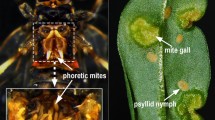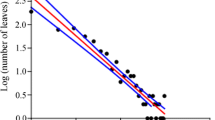Abstract
We investigated relationships between host plant hybridization in the Quercus grisea x Q. gambelii species complex and the distribution and performance of a leaf-mining moth in the genus Phyllonorycter. In 2 years at two sites Phyllonorycter densities were lowest on Q. grisea and increased through the categories of hybrid host plants to Q. gambelii. Direct host plant effects on Phyllonorycter performance were consistent with Phyllonorycter distribution; unexplained mortality of larvae in the mines, which is often associated with direct plant effects, decreased from Q. grisea through the hybrids to Q. gambelii. Plant hybridization influenced parasitism of Phyllonorycter. Parasitism was density dependent, and across all densities was higher on Q. grisea and Q. gambelii than on hybrid host plants.
Similar content being viewed by others
References
Aguilar JM, Boecklen WJ (1992) Patterns of herbivory in the Quercus grisea x Quercus gambelii species complex. Oikos 64:498–504
Anderson E (1953) Introgressive hybridization. Biol Rev 28:280–307
Arnold ML, Hamrick JL, Bennett BD (1990) Allozyme variation in Louisiana irises: a test for introgession and hybrid speciation. Heredity 65:297–306
Askew RR, Shaw MR (1986) Parasitoid communities: their size, structure and development. In: Waage J, Greathead D (eds) Insect parasitoids, Academic Press, New York, pp 225–264
Barber HN (1970) Hybridization and the evolution of plants. Taxon 19:154–160
Benedetti JK, Brown MD (1978) Strategies for the selection of log-linear models. Biometrics 34:680–686
Boecklen WJ, Larson KC (1994) Densities of gall-forming wasps (Hymenoptera: Cynipidae) in an oak hybrid zone: a test of competing hypotheses. In: Price PW, Baranchikov Y, Mattson WJ (eds) The ecology, physiology, and evolution of gall-forming insects. USDA Forest Service General Technical Report, NC (in press)
Boecklen WJ, Spellenberg R (1990) Structure of herbivore communities in two oak (Quercus spp.) hybrid zones. Oecologia 85:92–100
Cottam WP, Tucker JM, Santamour FSJr (1982) Oak hybridization at the University of Utah. State Arboretum of Utah, Publication no. 1. University of Utah Press, Salt Lake City, Utah
Clancy KM, Price PW (1986) Temporal variation in three-trophiclevel interactions among willows, sawflies, and parasites. Ecology 67:1601–1607
Dixon WJ, Brown MB, Engelman L, Jennrich RI (1990) BMDP statistical software manual. University of California Press, Berkeley, Calif
Drake DW (1981) Reproductive success of two Eucalyptus hybrid populations. I. Generalized seed output model and comparison of fruit parameters. Aust J Bot 29:25–35
Floate KD, Whitham TG (1993) The “hybrid bridge” hypothesis: host shifting via plant hybrid swarms. Am Nat 141:651–662
Floate KD, Whitham TG (1994) Aphid-ant interaction reduces chrysomelid herbivory in a cottonwood hybrid zone. Oecologia 97:215–221
Floate KD, Kearsley MJC, Whitham TG (1993) Elevated herbivory in plant hybrid zones: Chrysomela confluens, Populus and phenological sinks. Ecology 74:2056–2065
Fritz RS, Orians CM, Brunsfeld SJ (1994) Interspecific hybridization of plants and resistance to herbivores: hypotheses, genetics, and variable responses in a diverse herbivore community. Oecologia 97:106–117
Grant V (1963) The origins of adaptations. Columbia University Press, New York, NY
Gross P (1991) Influence of target pest feeding niche on success rates in classical biological control. Environ Entomol 20:1217–1227
Hanhimaki S, Senn J, Haukioja E (1994) Performance of insect herbivores on hybridizing trees: the case of the subarctic birches. J Anim Ecol 63:163–175
Hawkins BA (1988) Species diversity in the third and fourth trophic levels: patterns and mechanisms. J Anim Ecol 57:137–162
Hawkins BA, Lawton JH (1987) Species richness for parasitoids of British phytophagous insects. Nature 326:788–790
Johnson LPV (1939) A descriptive list of natural and artificial interspecific hybrids in North America Forest-tree genera. Can J Res 17:411–444
Lawton JH (1986) The effect of parasitoids on phytophagous insect communities. In: Waage J, Greathead D (eds) Insect parasitoids. Academic Press, New York, pp 265–287
Manley SAM, Fowler DP (1969) Spruce budworm defoliation in relation to introgression in Red and Black Spruce. For Sci 15:365–366
Moorehead JR, Taper ML, Case TJ (1993) Utilization of hybrid oak hosts by a monophagous gall wasp: how little host character is sufficient? Oecologia 95:385–392
Moulia C, Aussel JP, Bonhomme F, Boursot P, Nielsen JT, Renaud F (1991) Wormy mice in a hybrid zone: a genetic control of susceptibility to parasite infection. J Evol Biol 4:679–687
Nothnagle PJ, Schultz JC (1987) What is a forest pest? In: Barbosa P, Schultz JC (eds) Insect outbreaks. Academic Press, New York, pp 59–80
Ownbey M (1950) Natural hybridization and amphiploidy in the genus Tragopogon. Am J Bot 37:487–499
Paige KN, Capman WC (1993) The effects of host-plant genotype, hybridization, and environment on gall-aphid attack and survival in cottonwood: the importance of genetic studies and the utility of RFLPS. Evolution 47:36–45
Palmer EJ (1948) Hybrid oaks of North America. J Arnold Arbor 29:1–48
Price PW, Bouton CE, Gross P, McPheron BA, Thompson JN, Weis AE (1980) Interactions among three trophic levels: influence of plants on interactions between insect herbivores and natural enemies. Annu Rev Ecol Syst 11:41–65
Rabb RL, Bradley JR (1968) The influence of host plants of parasitism on eggs of the tobacco hornworm. J Econ Entomol 61:1249–1252
Randall MGM (1982) The dynamics of an insect population throughout its altitudinal distribution: Coleophora alticolella (Lepidoptera) in Northern England. J Anim Ecol 51:993–1016
Rieseberg LH, Carter R, Zona S (1990) Molecular tests of the hypothesized hybrid origin of two diploid Helianthus species (Asteraceae). Evolution 44:1498–1511
Rushton BS (1993) Natural hybridization within the genus Quercus L. Ann Sci For 50:73–90
Soetens PH, Rowell-Rahier M, Pasteels JM (1991) Influence of phenolglucosides and trichome density on the distribution of insects (sic) herbivores on willows. Entomol Exp Appl 59:175–187
Tucker JM (1961) Studies in the Quercus undulata complex. I. A preliminary statement. Amer J Bot 48:202–208
Vinson SB (1976) Host selection by insect parasitoids. Annu Rev Entomol 21:109–133
Whitham TG (1989) Plant hybrid zones as sinks for pests. Science 244:1490–1493
Whittaker JB (1971) Population changes in Neophilaenus lineatus (L.) (Homoptera: Cercopidae) in different parts of its range. J Anim Ecol 40:425–443
Whittemore AT, Schaal BA (1991) Interspecific gene flow in sympatric oaks. Proc Natl Acad Sci USA 88:2540–2544
Wellings PW, Dixon AFG (1987) The role of weather and natural enemies in determining aphid outbreaks. In: Barbosa P, Schultz JC (eds) Insect outbreaks. Academic Press, New York, pp 314–346
Author information
Authors and Affiliations
Rights and permissions
About this article
Cite this article
Preszler, R.W., Boecklen, W.J. A three-trophic-level analysis of the effects of plant hybridization on a leaf-mining moth. Oecologia 100, 66–73 (1994). https://doi.org/10.1007/BF00317131
Received:
Accepted:
Issue Date:
DOI: https://doi.org/10.1007/BF00317131




